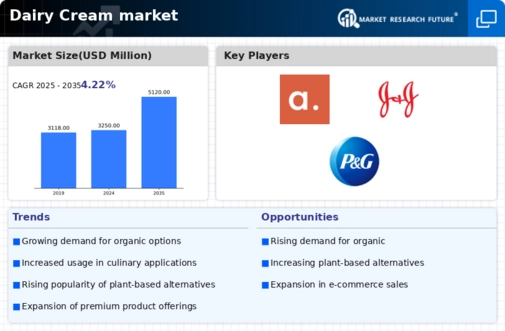Diverse Culinary Applications
The versatility of dairy free-cream-cheese in various culinary applications is a notable driver for the market. This product can be utilized in a wide range of recipes, from spreads and dips to baked goods and desserts. The dairy free-cream-cheese market is likely to see increased demand as chefs and home cooks alike explore innovative ways to incorporate these alternatives into their meals. The growing trend of plant-based cooking classes and recipe sharing on social media platforms further supports this driver, as consumers seek to experiment with dairy-free options. As culinary creativity flourishes, the market may experience a surge in interest and sales, indicating a vibrant future.
Expansion of Product Offerings
The dairy free-cream-cheese market is experiencing a notable expansion in product offerings, which serves as a key driver for growth. Manufacturers are increasingly introducing a variety of flavors and formulations to cater to diverse consumer preferences. This trend is evidenced by the introduction of unique flavors such as garlic herb and spicy jalapeno, appealing to a broader audience. The dairy free-cream-cheese market is likely to benefit from this diversification, as consumers seek out innovative and exciting options. Furthermore, the introduction of organic and non-GMO certified products may attract health-conscious buyers, suggesting that the market could continue to thrive as it adapts to evolving consumer demands.
Health Consciousness Among Consumers
The increasing awareness of health and wellness among consumers appears to be a pivotal driver for the dairy free-cream-cheese market. As individuals become more informed about dietary choices, there is a noticeable shift towards plant-based alternatives. This trend is reflected in a survey indicating that approximately 60% of consumers in the US are actively seeking dairy-free options due to perceived health benefits. The dairy free-cream-cheese market is likely to benefit from this growing consumer base, as individuals prioritize products that align with their health goals. Furthermore, the rise in lactose intolerance and dairy allergies contributes to the demand for dairy-free products, suggesting that the market may continue to expand as more consumers seek suitable alternatives.
Influence of Social Media and Food Trends
The role of social media in shaping food trends cannot be understated, particularly in the dairy free-cream-cheese market. Platforms such as Instagram and TikTok have become influential in promoting plant-based diets, with many users sharing recipes and experiences related to dairy-free products. This visibility appears to drive consumer interest and awareness, potentially leading to increased sales in the dairy free-cream-cheese market. Additionally, the rise of food influencers advocating for dairy-free lifestyles may further encourage consumers to explore these alternatives. As social media continues to evolve, its impact on food trends is likely to remain a crucial driver for the market.
Sustainability and Environmental Concerns
Sustainability has emerged as a significant concern for consumers, influencing their purchasing decisions in the dairy free-cream-cheese market. Many individuals are increasingly aware of the environmental impact of dairy farming, leading to a preference for plant-based products. Research indicates that the production of dairy alternatives can result in up to 80% lower greenhouse gas emissions compared to traditional dairy products. This growing emphasis on sustainability is likely to drive the dairy free-cream-cheese market, as brands that prioritize eco-friendly practices may attract environmentally conscious consumers. Additionally, the potential for reduced water usage in the production of dairy-free alternatives further enhances their appeal, suggesting a promising future for the market.














Leave a Comment